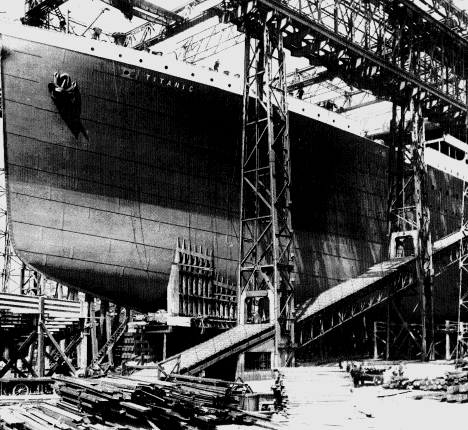General Information
![]()

![]()
General Information
![]()

![]()
Following the Titanic's launch on May 31, 1911, her machinery and interiors
were installed. 29 Boilers, along with thier coal bunkers, filled six of
the Titanic's 16 water tight compartments. Two triple expansion reciprocating
steam engines were aft of these boiler rooms, capable of generating 15,000
horsepower each. These giant engines, the largest of their kind ever, ran
the wing propellers at 75 rpm. Behind the main engine room was a special
Parson's low pressure steam turbine amidships that generated 16,000 horsepower.
Instead of allowing the steam to escape as exhaust from the reciprocating
engines, it was led into this turbine which turned the centre propeller
at 165 rpm. The Titanic and her two sister ships were the largest liners
to employ such a propulsion system, which was an innovation at the time.
It would allow the Titanic to cruise effortlessly at 21 knots with almost
no vibration.
It has
been said that more care and detail was lavished on the Titanic's interiors
than on any vessel before or since. There were seven magnificent grand
staircase landings, two huge wrought iron and glass domed skylights, four
elevators, a gymnasium, swimming pool, squashracquet court and Turkish
baths. There was the Cafe Parisien and a pair of parlour suites that would
cost £1500 / $4350 a voyage each containing a 50 foot private promanade.
There was a Hospital with an operating room, a library, post office and
a 50 phone switchboard. The Titanic was designed to carry 2,500 passengers
and a crew of about 900. The British Board of Trade specified 16 lifeboats;
White Star Line provided 20. (the designer originally intended for 64 lifeboats).
When finally completed, she weighed 46,328 gross tons - the largest ship
afloat. Despite a brisk wind during her sea trials, the Titanic suprised
everyone by achieving a speed of 24 knots "with ease" well exceeding
her builders expectations. On April, 10, 1912, the Royal Mail Steamship
Titanic left Southampton, England on her maiden voyage, bound for New York.
The world has yet to recover fully from the shock of the events that followed. The "unsinkable Titanic" grazed an iceberg late on the evening of April 14, slicing open one-third of her length to the sea, and sank two hours and forty minutes later, leaving over 1,500 people to freeze in the icy waters of the North Atlantic. It remains to this day history's most incredible controversial marine disaster.
Despite the horror of the catastrope, several benefits resulted. The
unsinkable ship was a myth - all vessels henceforth carried enough lifeboats
to save all aboard, lifeboat drills became common practice, as well as
a 24 hour wireless vigil. The shipping lanes were moved farther south for
that time of year, and 1914 saw the creation of the International Ice Patrol.
 Titanic in her slipway during her final preparations for launching.
Titanic in her slipway during her final preparations for launching.

